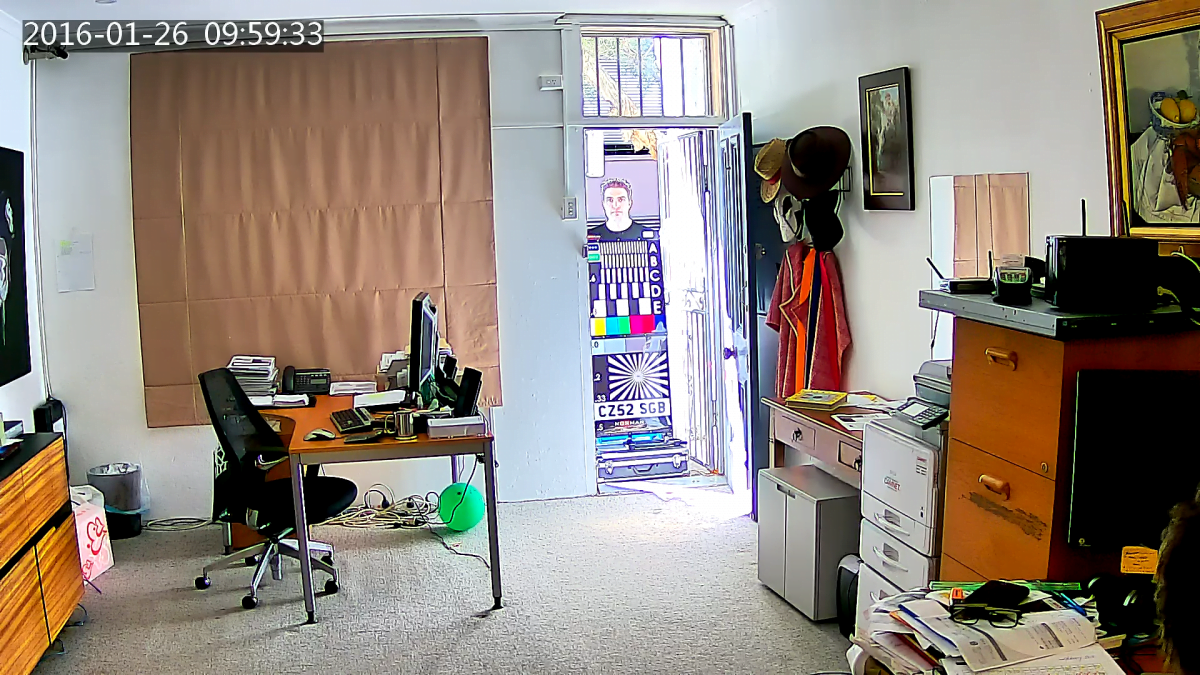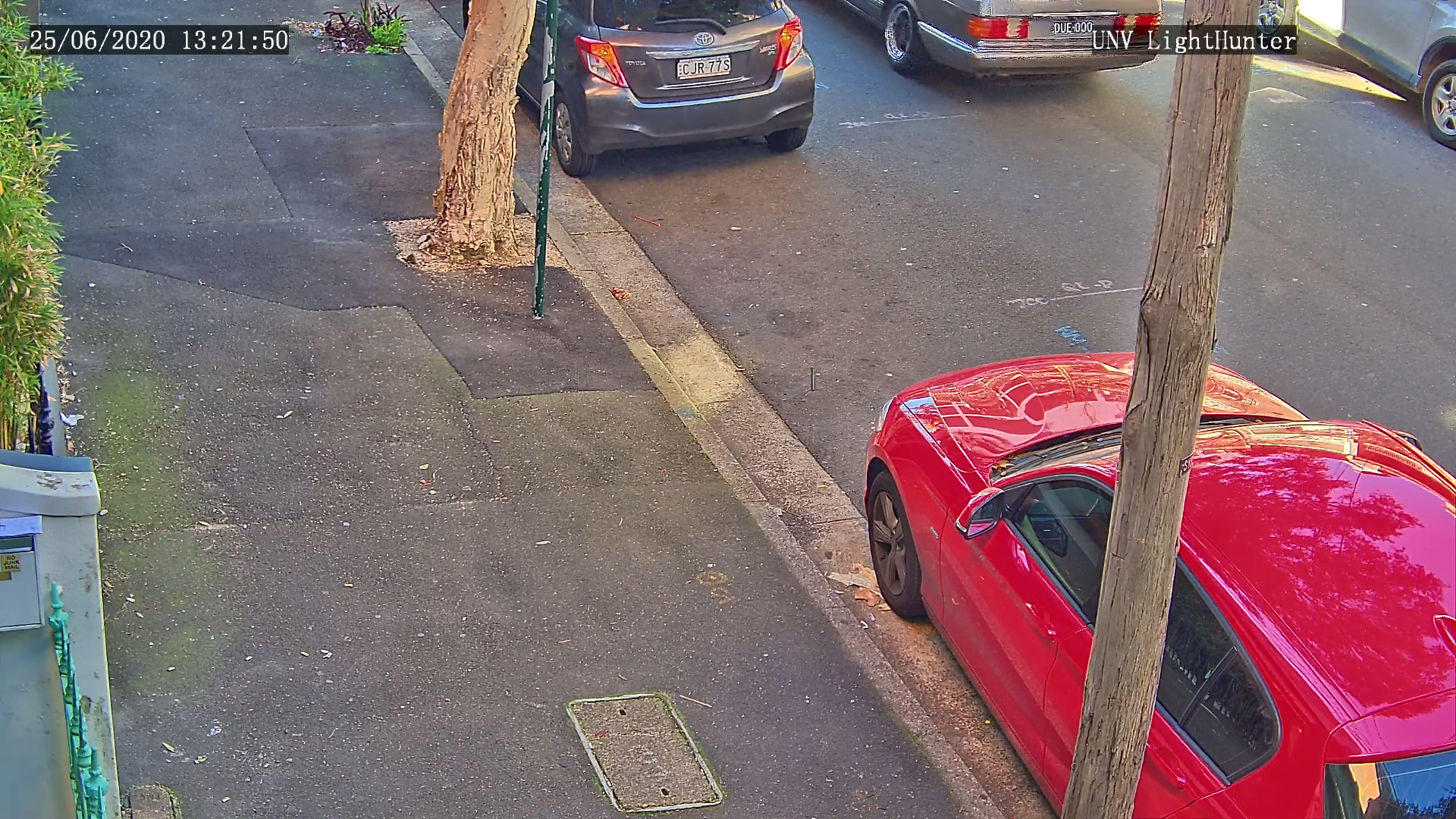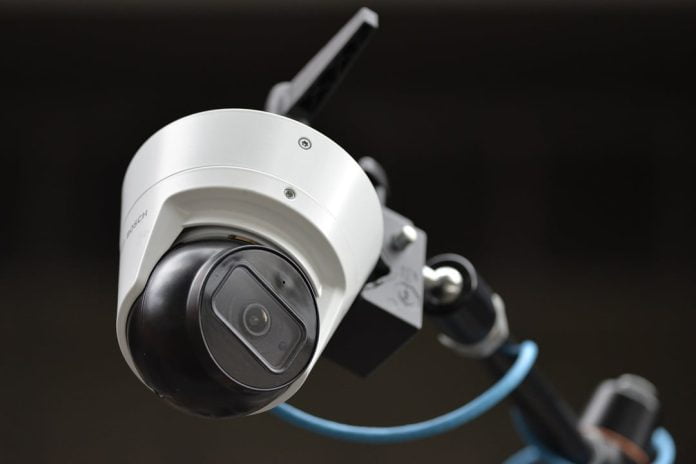Bosch FLEXIDOME IP Turret 3000i IR is a compact day/night PoE turret camera and the NTV-3503-F02L version we are testing has a 2.3mm F1.6 aperture fixed lenses and strong resolution of 3072 x 1728 pixels for a total of sensor area of 5.3MP.
Bosch FLEXIDOME IP Turret 3000i IR – our test camera is the NTV-3503-F02L – is a compact turret with a modest current draw offering solid all round performance, that’s best in good to low-ish light. The camera has serious resolution and a monster 120-degree angle of view, thanks to the squat 2.3mm focal length of its moderately fast fixed lens. The camera makes the most of these attributes to deliver good situational awareness, with court admissible faces to 10-15 metres and excellent recognition and observation qualities further still.
Thanks to its robust cast alloy construction, the camera is rated IK08 against vandals striking at 5 joules impact – the equivalent of the impact of a 1.7 kg mass dropped from 300mm above a surface. There’s also IP42 rating for protection against tools and small wires greater than 1mm and from water sprays at less than 15 degrees from vertical.
Before we go further, let’s run through some specifications. This version of the 3000i turret features Intelligent Dynamic Noise Reduction with separate temporal and spatial adjustments, intelligent defog, video content analysis with rule-based alarms and tracking, line crossing, enter/leave field, follow route, loitering, idle/removed object, people counting, crowd density estimation and 3D tracking. Additional functions include privacy masking via 8 independent areas, fully programmable display stamping of name, logo and time, as well as alarm messages and pixel counter of selectable areas.

The camera’s internal RAM can store up to 5 seconds of pre-alarm recording, while a microSDHC/microSDXC SD card slot supports 1TB cards for more complex automatic network replenishment (ANR) edge recording requirements. The camera has a built-in microphone to allow operators to listen in on the monitored area. Audio detection can be used to generate an alarm if needed. Full duplex audio streaming options includes standard G.711 with an 8 kHz sampling rate through to AAC-LC running at 80 kbps and a 16 kHz sampling rate. Signal-to-noise ratio is less than 50dB.
Adjustable picture settings include contrast, saturation, brightness, white balance (2500 to 10000K), 4 automatic modes (basic, standard, sodium lamp, dominant colour), manual and hold mode, the video functions include ALC, there’s automatic electronic shutter (AES); fixed shutter from (1/30 to 1/15000) selectable and default. You can select day/night auto (adjustable switch points), colour, monochrome, video functions – enhance, there’s selectable sharpness enhancement, backlight compensation and contrast enhancement.
There’s also fully configurable H.265 multi-streaming. According to Bosch, the camera is designed on the most efficient and powerful H.264 and H.265/HEVC encoding platform and can deliver quality images stream at low bitrates. The 3000i supports ONVIF Profile S, ONVIF Profile G and ONVIF Profile T, as well as GB/T 28181.
Data security is a Bosch priority, and the company says measures have been put in place to ensure the highest level of security for device access and data transport. The 3-level password protection with security recommendations allows users to customize device access. Web browser access can be protected using HTTPS and firmware updates can also be protected with authenticated secure uploads. Bosch says the on-board Trusted Platform Module (TPM) and Public Key Infrastructure (PKI) support guarantee superior protection from malicious attacks. The 802.1x network authentication with EAP/TLS, supports TLS 1.2 with updated cipher suites including AES 256 encryption.

This camera is 122 x 129mm in size, weighs 576g and runs on POE IEEE 802.3af/802.3 at Type 1, Class 3 on a voltage of 12V DC with a 30 per cent variation either way. Maximum draw is 10.5W, with a standard draw of around 3.5W.
The camera head features 3-axis adjustment through pan/tilt and rotation (pan is to 350 degrees, while tilt is from 0-78 degrees), while the operating temperature range is -20 to 50C. Assisting installations are mirror image function, image rotation options from 0-270 degrees, and camera LED disable. A wide range of configuration options is available for alarm activations signalling camera tampering and a built-in algorithm for detecting movement in the video stream can also be used to signal tamper alarms.
Bosch quotes DORI figures for the 5MP turret with 2.3mm lens – detection at 37 metres (25px/m), observation at 15 metres (63px/m) recognition at 7 metres at (125px/m) and identification at 4 metres (250 px/m). These are stringent numbers – I think the camera pushes court admissible identity out past 10 metres, though this margin shrinks as light levels drop.
Test Driving Bosch FLEXIDOME IP Turret 3000i IR
The camera surprised right from the start with its sure-footed performance in more than slightly horrible variable lighting conditions that moved between deep shadow and glaring backlight. Initial settings are close to default for the test – sharpening is elevated, and backlight compensation is on, while intelligent dynamic noise reduction and dynamic sharpness and noise filtering are both activated. With these settings, the camera shows off excellent all-round performance during daylight hours in good light.
This should come as no surprise – we were very impressed with the Bosch 3000i Bullet recently and there’s some technical crossover in the family. The turret form factor tends to make you think performance will be a compromise. Instead what you get with the FLEXIDOME 3000i IR is a very wide angle of view arm-in-arm with excellent resolution delivering solid performance in good and failing light.


There’s a distance – it’s around 15-20 metres – where subjects move out of the lens’ optimum focal plane, as well as moving into the area of pixel spread – where softness becomes apparent. But within that distance through a monster 120-degree angle of view, Bosch’s FLEXIDOME IP turret 3000i IR delivers strong sharpness, contrast and colour, and low blur. It’s a combination that makes this camera a real powerhouse for mid-range applications where you need to see everything all the time.
Our test starts in the morning and it’s immediately apparent the 3000i turret does solid work against backlight. I have court admissible faces on my side of the street, though I never feel I have them over on the bright side of the road – about 12-plus metres from the lens. Performance with snaring plates is pretty good, too, considering the angle of view and the pixel spread it engenders. During the middle period of the day, as the light swings wildly from glaring 70,000 lux to gloomy 14,000, I remain sure that with a bit of fiddling I could dredge plates out of the middle of my scene.


Considering the enormity of the angle of view – it really is huge, stretching from the line of terraces on the left all the way around to a point past 90 degrees over the road – performance is excellent. Colour tones are natural, perhaps a little muted as light levels fall and WDR performance is solid. I note a little veiling flare from the turret face, which is mounted on the Magic Arm at right angles to the ground, but that’s is not a typical application for a turret.
Something I do like for a street application like this, is that I am getting faces and similarly high levels of detail all the way in from 10 metres through the full angle of view. I grab a couple of shots to highlight this capacity – it’s worth having. The view is not only wide, it’s taller than you’d see with a longer focal length – that brings in more detail still. You don’t think about it until you’re noticing people’s shoes and socks within 8m – even within 4m – usually this close to the lens where detail is highest, those details would have moved out of your horizontal or vertical angles of view.


The image stays solid all afternoon – it’s moving into autumn here in Sydney, so the sun is a bit lower in the northern sky. This and the partial, thick cloud cover, start to have an impact later in the day. I begin getting some softness in the image. I notice it first in vehicles and then in faces. Because of the variable light – by this time I have an intense bright patch to the right of the scene, with shade through the rest of the angle of view – I spend a bit of time trying to wrap camera settings around the application. After turning backlight on and off a few times, I feel I am getting more amplification noise without it and put up with a slightly darker scene.
Fast moving plates are gone by 430pm but I still have court admissible faces at 6.20pm when the light has evened out and I hang onto them till around 7pm, when light fades faster. You’d expect a comparatively compact camera sensor with 5.3MP resolution and a very wide angle of view to tend to be softer in low light thanks to pixel spread and smaller photo sites, and that’s how it proves to be. Something I do notice is that the camera refuses to shunt over into monochrome in sub 4 lux on the street. By this time there’s fore and aft tone mapping of fast-moving cars, and tone mapping is evident around pedestrians, too. It’s not about frame rate – it’s the way the camera manages areas of activity while ensuring slender bitrates.


Static details are high at 8pm in full dark. There’s slight yellow colour casting at the bottom of the street. In this light level, identifying pedestrians and vehicle plates is not possible – there’s blur and amplification noise – but the static parts of the scene are tidy – sharper close to the lens. Light balance across the frame is good, too, as is colour rendition. There are no dark holes in this scene at all, and I find I’m able to get vehicle makes, models, colours, modifications without any trouble and depth of field is good – I have detection of people and vehicles very deep into the scene.
I have to push the camera into night mode to get a look at IR performance in monochrome. The IR array offers 15 metres of reach – that’s conservative – I can see IR flare from plates up to 25 metres away. Something else I notice immediately is that the IR array’s spread is relatively narrow compared with the large optical angle of view – it’s also relatively strong. I’m happier with IR performance inside 8 metres with the IR array backed right off, especially if there’s a touch of ambient light from adjacent flood lights or from carried smart devices.



Assisted night performance does a good job with pedestrians outside of face recognition – I have gait, attire, head shape, hair tone and style, footwear design, carried items. With IR activated I have recognition of a person by those who knew them or from photographs. The camera’s observation capabilities are also enhanced with IR on – I can see people walking on the road at 20 metres and again, these images would allow recognition by friends or family.
I spend a lot of time playing with camera settings in support of IR, particularly shutter speed, and find the best street performance with movement at close range is using a shutter speed of around 100th of a second and keeping IR on its lower settings. For general detection or observation of complex scenes, colour at default was preferable.
Conclusions
FLEXIDOME IP turret 3000i IR is a solid camera, well built and with plenty of smart functions, including onboard analytics and clever event reporting. The camera’s resolution and enormous angle of view – wide and tall – means that within 15 metres of the lens in good light it gives levels of detail you’d never get with a longer lens. During the day and within 10 metres, court admissible face recognition is standard fare and moving plates can be recognised fully or partly using digital zoom. WDR performance is a particular strength.

In lower light levels the camera doesn’t give moving plates or faces, but general monitoring characteristics for detection or observation are good. The camera does best with the IR array eased off and responds well to the presence of ambient light. If you have a very wide view and your depth of field is from 10-15 metres, this FLEXIDOME IP turret 3000i IR is well worth a look.
#securityelectronicsandnetworks.com










informative guide